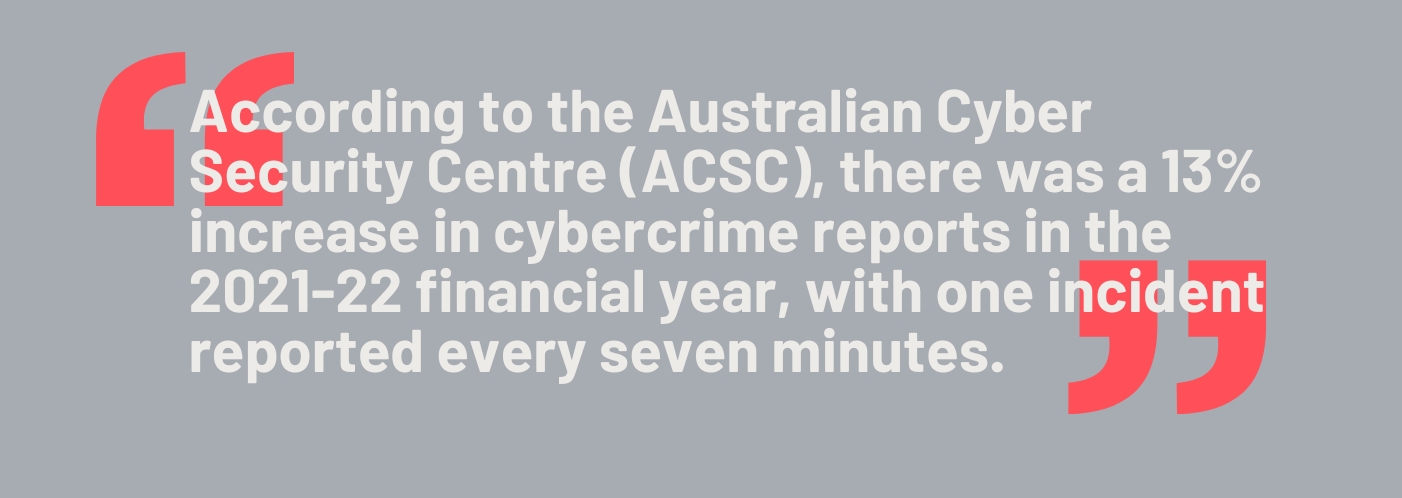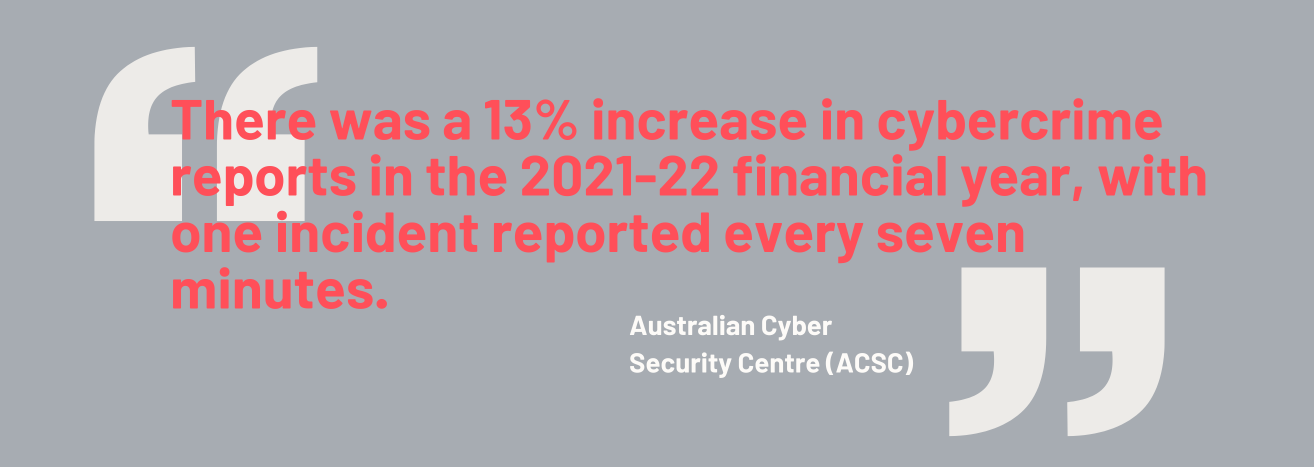Cybersecurity in the Boardroom: The Rising Demand for Tech-Savvy Executives
In today's world, digital transformation is reshaping industries, and cyber threats are becoming increasingly sophisticated. Cybersecurity has emerged as a critical boardroom issue.
For Australian businesses, the need for tech-savvy executives who can navigate the complex landscape of digital risks and opportunities has never been more pressing. Let's explore why cybersecurity expertise is becoming a must-have in the boardroom and how companies can address this growing demand.
The Australian Cybersecurity Landscape and its Importance
The cybersecurity situation in Australia is both urgent and evolving. According to the Australian Cyber Security Centre (ACSC), there was a 13% increase in cybercrime reports in the 2021-22 financial year, with one incident reported every seven minutes. The average cost of a data breach for Australian organisations reached AUD 4.5 million in 2022, as reported by IBM's Cost of a Data Breach Report. The Australian Government's Cyber Security Strategy 2020 emphasises the need for businesses to prioritise cybersecurity at the highest levels of leadership.
Cybersecurity is no longer just an IT issue; it's a core business risk that can impact strategy, operations, and reputation. With evolving data protection laws, boards must ensure their organisations comply with regulatory requirements. Shareholders and investors increasingly scrutinise companies' cybersecurity preparedness. Effective cyber risk management requires board-level oversight and understanding. As companies digitise operations, cybersecurity becomes integral to business continuity and innovation, and boards play a crucial role in overseeing cyber incident response and crisis management plans.

The Growing Demand and Key Competencies
The need for cybersecurity expertise in the boardroom is driving trends, such as creating dedicated board positions for cybersecurity experts, upskilling existing board members, seeking members with varied tech backgrounds, establishing tech advisory boards, and focusing on cybersecurity experience in executive and board member searches.
Tech-savvy executives in the boardroom should possess a strategic cybersecurity vision, risk assessment skills, regulatory knowledge, crisis management experience, digital transformation insight, technical literacy, and vendor management skills. They need to align cybersecurity strategies with overall business objectives, evaluate and prioritise cyber risks, understand cybersecurity laws, guide organisations through cyber incidents, understand how cybersecurity intersects with digital innovation, grasp key cybersecurity concepts, and oversee cybersecurity in the supply chain.
Challenges, Strategies and the Role of Executive Search
Several obstacles can hinder the integration of cybersecurity expertise at the board level, including a skill gap, communication barriers, rapid technological change, competing priorities, and cultural resistance.
To enhance cybersecurity expertise in the boardroom, companies can implement strategies such as targeted recruitment, continuous education, regular briefings, cyber risk frameworks, scenario planning, external expertise, and board committee focus. Actively seek board members with cybersecurity and digital transformation experience, implement ongoing cybersecurity training programs, schedule frequent updates from CISOs, adopt comprehensive frameworks for assessing and managing cyber risks, conduct regular cybersecurity scenario exercises, engage cybersecurity consultants, and establish a dedicated cybersecurity committee.
Executive search firms are adapting to meet the growing demand for tech-savvy executives by expanding search criteria, looking beyond traditional sectors for talent, developing specialised assessment tools, analysing board composition to identify skill gaps, and assisting in developing succession plans that incorporate cybersecurity expertise.

Strategies for Bridging Generational Gaps
To overcome these challenges, companies can implement several strategies. Promoting open communication is crucial, encouraging transparent dialogue about generational differences and similarities and creating forums for sharing diverse perspectives and experiences. Implementing reverse mentoring programs, pairing younger executives with older ones for mutual learning, can be beneficial. Focus on technology, market trends, and leadership styles. Emphasising shared goals, aligning the C-suite around common organisational objectives, and highlighting how diverse perspectives contribute to achieving these goals is also essential. Customise leadership development, tailoring programs to address generational strengths and challenges, and focus on building adaptability and cross-generational leadership skills. It's important to foster a culture of inclusion, promoting an environment where all perspectives are valued, regardless of age, and address and mitigate age-related biases and stereotypes. Leverage technology wisely, using collaboration tools that cater to different generational preferences, and provide technology training to ensure all executives can effectively use necessary tools. Create processes that respect established practices while encouraging fresh approaches and implement decision-making frameworks that incorporate diverse viewpoints. Offering flexibility in work styles and arrangements to accommodate different generational preferences and focus on results rather than traditional work patterns can also help to bridge gaps.
Case Study: Success in Multi-Generational Leadership
Consider an example of an ASX 200 company in the financial services sector that revamped its C-suite to include executives from three generations. The CEO (Gen X) implemented a reverse mentoring program, pairing the CFO (Baby Boomer) with the Chief Digital Officer (Millennial). This initiative led to a 20% increase in digital product adoption among older customers and a more robust risk management approach in new digital ventures.
The Role of Executive Search in Building Multi-Generational C-Suites
At Oceans Group, we play a crucial role in helping organisations build effective multi-generational leadership teams. We ensure our executive searches include qualified candidates from various generations, and we evaluate candidates' ability to work effectively in multi-generational environments. We also assess how candidates from different generations align with and can enhance company culture, and we provide guidance on integrating executives from different generations into existing leadership teams. Finally, we help organisations develop succession strategies that leverage multi-generational talent.
Measuring Success in Multi-Generational C-Suites
Key metrics to evaluate the effectiveness of a multi-generational C-suite include innovation metrics (e.g., new product development, process improvements), employee engagement scores across different age groups, customer satisfaction across diverse age segments, decision-making speed and quality, revenue and profitability growth, and retention rates of executives across generations.
Future Trends in Multi-Generational Leadership
Looking ahead, we anticipate several developments, including the use of AI tools to facilitate better understanding and collaboration across generations and an increased focus on developing executives' ability to work across generational lines through generational intelligence training. We also anticipate the implementation of more formalised policies to ensure age diversity and inclusion at executive levels, the tailoring of executive compensation and benefits to generational preferences, and a greater emphasis on leveraging generational diversity to understand and serve an age-diverse customer base.
Conclusion
The multi-generational C-suite is not just a demographic reality; it's a strategic opportunity. Companies that effectively manage generational diversity can drive innovation, foster collaboration, and achieve optimal performance. By embracing the strengths of each generation and implementing strategies to bridge potential gaps, Australian businesses can build high-performing leadership teams that are well-equipped to navigate the challenges and opportunities of today's rapidly changing world.







